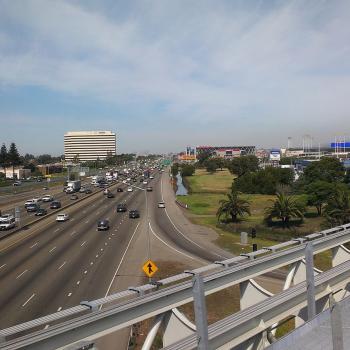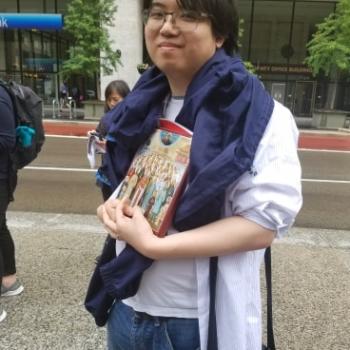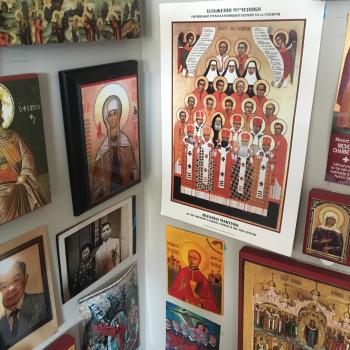My name is Justin Tse, and I am a person.
As Orthodox theologian Christos Yannaras says, a person is ‘all light, all face, all eye,’ faced by the faces of others so that one’s face is turned toward the other. In a world that demands our adherence to the politics of identity – ‘being itself in so far as it is supported by “false consciousness,”‘ as theorist Slavoj Žižek puts it – I simply want to be known as a person. Through such knowledge, perhaps one day my love for my neighbour as myself will be made perfect.
Being a person, I think, lies somewhere near the heart of being Catholic. I used to think that ‘Catholicism’ was an identity, which meant that for the longest time, I thought that I couldn’t be Catholic; I was, after all, Protestant. I used to write, for example, on a blog called A Christian Thing as an anonymous character called Chinglican at Table because I am Chinese and I was Anglican. I thought that I was being clever by identifying as ‘Chinglican’ and then saying that my identity could be put in conversation with other identities at a table of communion. But because I work in the secular university, I was also nervous about my religious identity, so I also blogged separately at Religion Ethnicity Wired, where I tried my best to keep a neutral stance on religion. As it turns out, I wrote out of my theological commitments on both blogs because theology isn’t really about identity; it’s ultimately about God facing me and me facing God. As anthropologist Talal Asad points out, this artificial division between theology and religious studies is, in a word, ‘protestantizing’ because it reduces both religion and theology to an airy-fairy ‘faith’ in ideologies and identities. In the end, it was God’s personal love that made these demands of individualism and indifference impossible.
As I was received into communion with the apostolic churches, I learned that being ‘Catholic’ is not about a religious identity, but simply about how the people of God – from the hierarchy to the laity – face me and I face them, especially as our communion in the Holy Spirit is mediated through the concrete material of the Eucharist, the holy icons, and the various other mysteries of encounter. Because of this Catholic view of religion as not an ‘identity’ but as simply being a person faced by other persons, I became comfortable merging the two blogs and importing them into this one here on Patheos Catholic. I no longer have the same qualms about hiding the way the church faces me from my academic profession because the university is the world in which others face me as I face them in scholarly interactions. To be a scholar is simply to meditate on the world in this age critically and compassionately as a person. As John Henry Newman rightly understood it, the university is therefore truly a catholic place because it is personal; this orientation toward the world in this age (the ‘saeculum’), in turn, is also why every university is truly secular as well. In fact, my PhD is in Geography from the University of British Columbia in Vancouver, BC, which means that I spend most of my time writing about the secular world in catholic dialogue with my colleagues and various other readers.
I am an Eastern Catholic person because the way that the people of God face me is through an Eastern Catholic Church. When I was received into the Catholic Church, I joined the Ukrainian Greco-Catholic Church, one of the twenty-three self-governing Eastern Catholic Churches in full communion with the Bishop of Rome. We worship the Triune God in what is called the ‘Kyivan’ tradition – one that reflects our Byzantine origins from Constantinople – as our church comes from the city of Kyiv but seeks to bless the whole world.
But aside from being ‘Orthodox in communion with Rome,’ being Eastern Catholic also has other perks. For example, I am an Asian American; in fact, I am currently Visiting Assistant Professor of Asian American Studies at Northwestern University in Evanston, IL. But being ‘Asian American’ – or as a Chinese American, a ‘jook sing’ (hollow bamboo – i.e. Chinese with a selective knowledge of ‘Chinese culture’) – is also not an identity, but a way of being faced by other persons in a body marked as ‘Asian.’ To be ‘Asian American,’ as far as I understand the movement, simply is to inhabit a body that others constantly see as ‘oriental’ with the radical understanding that I am a person, not a rug. I have been corrected before by know-it-alls who think that I am being cute by referring to myself as ‘Eastern Catholic’ because I practice an Asian American politics. I must admit that sometimes I do intend this conflation to be facetious, which means that I am indeed being cute and therefore also slightly perverse, but I enjoy it very much, especially because it keeps me from making my racialized body an absolute point of reference in my theological reflections while acknowledging that race remains a reality in how persons in the modern world face each other and is therefore a point for theological reflection.
Put simply, I write as a person who is faced by the people of God in the Eastern Catholic Church. This blog – a ‘weblog’ – is a log on the web about how my neighbours are facing me, I am facing them, and together, we are facing God, whose face shines upon us and envelops us with his energies so that we too can shine with the Uncreated Light of Tabor.



